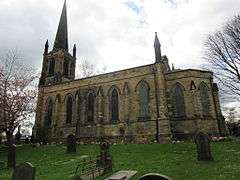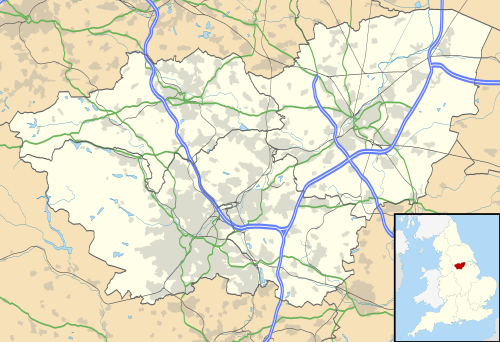Elsecar
| Elsecar | |
 Holy Trinity Parish Church in Elsecar |
|
 Elsecar |
|
| Population | 2,500 (2001) |
|---|---|
| OS grid reference | SE389001 |
| – London | 145 mi (233 km) S |
| District | Barnsley |
| Shire county | South Yorkshire |
| Region | Yorkshire and the Humber |
| Country | England |
| Sovereign state | United Kingdom |
| Post town | BARNSLEY |
| Postcode district | S74 |
| Dialling code | 01226 |
| Police | South Yorkshire |
| Fire | South Yorkshire |
| Ambulance | Yorkshire |
| EU Parliament | Yorkshire and the Humber |
| UK Parliament | Barnsley East |
Coordinates: 53°29′46″N 1°24′43″W / 53.496°N 1.412°W
Elsecar ![]() i/ˈɛlsᵻkɑːr/ is a village in the Metropolitan Borough of Barnsley in South Yorkshire, England. Like many villages in the area, it was for many years a colliery village until the widespread pit closures during the 1980s. Elsecar is near the town of Hoyland and the villages of Jump and Wentworth. Elsecar is 1.5 miles (2.4 km) south of Hoyland, 6 miles (9.7 km) south of Barnsley and 8 miles (13 km) north-east of Sheffield. The village falls within the Barnsley MBC Ward of Hoyland Milton.
i/ˈɛlsᵻkɑːr/ is a village in the Metropolitan Borough of Barnsley in South Yorkshire, England. Like many villages in the area, it was for many years a colliery village until the widespread pit closures during the 1980s. Elsecar is near the town of Hoyland and the villages of Jump and Wentworth. Elsecar is 1.5 miles (2.4 km) south of Hoyland, 6 miles (9.7 km) south of Barnsley and 8 miles (13 km) north-east of Sheffield. The village falls within the Barnsley MBC Ward of Hoyland Milton.
Elsecar is unique as a name: the origins are not entirely clear. Else or Elsi was the name of a local Saxon lord who owned land in the area. It is also the Saxon name for a marsh that may have existed in the bottom valley.
History
Industry
Elsecar was nothing more than a series of farms up until the 18th century. Although coal had been mined in the area since the 14th century the first colliery, Elsecar Old, did not open until 1750. The first proper mine shaft was sunk in 1795 at Elsecar New Colliery. The village was formed to take advantage of the coal resources in the area. Many of the new buildings were built by the Earl Fitzwilliam, who resided in nearby Wentworth Woodhouse, to house their workers. By the end of the century several pits were opened.
Two independent iron forge were opened at the turn of the 19th century; these also came under the ownership of the Fitzwilliam family after their respective companies collapsed. There was also a distillery which opened in 1814; however this only lasted four years. Two smaller family run forges were also established in the mid 19th century and they survived well into the 20th century. The two main forges were closed by the end of the century.
The last colliery to open was Elsecar Main in 1908: It was also the last to close in 1983. In 1988 the last pit in the area, Cortonwood, also closed. Elsecar Workshops were sold off by British Coal the following year, ending the village's ties to the coal industry. The village suffered from similar economic problems to all the mining villages in the region. There are still outstanding applications for mining parts of the village but these are unlikely to be acted upon.
Elsecar-by-the-Sea
In 1910 a local amateur photographer, Herbert Parkin, took some photographs of the local reservoir and surrounding areas and sent them into the Sheffield Star under the caption Elsecar-by-the-Sea. The name caught on and with the help of good transports link from Sheffield via the local railway station a thriving tourism business was established. The Hoyland council decided to create the public park to take advantage of the influx. The name is still jokingly used by some locals and to advertise events around the reservoir.
Attractions
Elsecar features the popular Elsecar Heritage Centre a living history centre and contains the only Newcomen steam engine in the world to have remained in its original location. Craft workshops, a monthly antiques fair and other special events are also held here.
There is also a public park with a bandstand, children's playground, a refreshment room, and a pitch and putt golf course. The reservoir, now a local nature reserve, is adjacent to the upper park.
Various remains of the industry of the village also remain. There is a plaque next to the top lock on the canal marking the former location of a colliery. Along the canal there are also some shaft heads from pumping stations left standing. The remains of iron mines can be found in undergrowth on the wooded section of Broadcar Lane.
Transport
Elsecar has its own railway station on the Hallam and Penistone lines so it is possible to make direct journeys to Sheffield, Leeds and Huddersfield. Buses run to and from Barnsley, Rotherham and Sheffield.
A railway junction named "Elsecar Junction" was located on the (now closed) Woodhead Line, some distance from Elsecar, close to the Wath marshalling yard. The line through Elsecar Junction, including Wath marshalling yard, closed in 1988.
The Elsecar Heritage Railway is based at the heritage centre. It currently runs between Rockingham Station (at the back of the heritage centre) and Hemingfield Basin. This service is currently for pleasure only; you cannot alight at Hemingfield Basin. There are plans to extend the line to Cortonwood and add regular stops. The railway is operated by steam locomotives, along with the "Earl of Strafford" diesel engine.
The Elsecar branch of Dearne and Dove Canal also terminates in the village. Currently only the top pond is usable but there are plans to restore the entire length.
Sport
The village has its own cricket club, established in 1854, which plays in the South Yorkshire Cricket League. It also has several junior teams that play in the Barnsley & District Junior Cricket Association.
It was represented in the FA Cup by Elsecar Main F.C. in the 1900s.
Notable people
- George Utley, Football player who turned out for Barnsley F.C., captained Sheffield United F.C. and played once England was born in Reform Row in Elsecar. He also won two FA Cup winners medals, one with each of his clubs.
- Sir Thomas Tomlinson Kt, BEM, JP (1877–1959) Tommy Tomlinson, as he was affectionately known locally, was one of the area's best known residents for over forty years and lived at 20 Fitzwilliam Street. In 1910 he became branch secretary of the Yorkshire Miners' Association and was elected to Hoyland UDC for the Elsecar ward in 1912 and to the West Riding County Council in 1921. Continuing as a Councillor for Hoyland UDC until 1940, he was chairman in 1921-3 and 1933-5. He occupied various posts at the Wesleyan Reform Church. He became a County Alderman in 1929 and was Chairman of the West Riding County Council 1946-9 and 1952-5. He was awarded the BEM (British Empire Medal) in 1945 and knighted in 1954.
- Arthur O'Loughlin, retired undefeated World kickboxing champion, was brought up in Hoyland and now lives in Elsecar with his wife, Christine. Arthur now owns 'Locky's', a bar in nearby Wombwell.
- Bobby Knutt, popular comedian and entertainer, has lived in Elsecar for several years.
- Laban Solomon, who lived on Church Street and died in 1903, aged 61, is buried in Elsecar churchyard beneath a kneeling angel, near the Wath Road.He was a well known composer, he being a particular favourite of Queen Victoria. He composed hymn tunes and other sacred music. He wrote tunes for such well known hymns as 'Oh, so bright' and 'All hail the power of Jesus' name,' as well as some more obscure ones, some written by the Rev E Doughty Solomon, a relation of his. For Sunday School Anniversaries he also supplied orchestral parts by post.
Photos
.jpg) View from the banks of Elsecar Reservoir.
View from the banks of Elsecar Reservoir..jpg) View from the banks of Elsecar Reservoir.
View from the banks of Elsecar Reservoir..jpg) View showing stone houses in Elsecar.
View showing stone houses in Elsecar. Photo showing road leading into Elsecar Village.
Photo showing road leading into Elsecar Village.
See also
- Dearne and Dove Canal
- Elsecar Heritage Centre
- Elsecar railway station
- Elsecar Heritage Railway
- Elsecar Collieries
References
- Population figures
- Howse, Geoffrey (1999), Around Hoyland, Sutton Publishing Limited, ISBN 0-7509-2268-0
- Howse, Geoffrey (2000), Around Hoyland A Second Selection, Sutton Publishing Limited, ISBN 0-7509-2726-7
- Howse, Geoffrey (2002) Around Hoyland People & Places, Sutton Publishing, ISBN 0-7509-3148-5
External links
![]() Media related to Elsecar at Wikimedia Commons
Media related to Elsecar at Wikimedia Commons